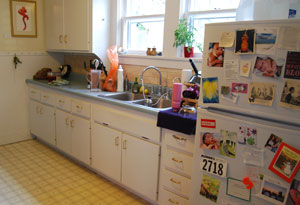What's Lurking in Your Cabinet?

Photo: Jessica Sain-Baird
How did one substance used as embalming fluid (formaldehyde) and another one that replicates something in our urine (urea) end up in our cabinets?
First, let's talk about the cabinets themselves. Unless your house is really old or you're really wealthy, your cabinets are likely made of particleboard, plywood or MDF (medium-density fiberboard). Particleboard is a composite material made of wood scraps like chips, shavings or sawdust, bound together with resins made of—you guessed it—formaldehyde, urea and other chemicals that make the woodlike substances stronger and more resistant to fire and water.
Particleboard does have eco-origins: It was developed during World War II as a way to salvage waste materials from factories and, during the 1950s, was incorporated into home design and perceived as an upgrade from solid wood.
Today, particleboard—and its stronger siblings, plywood and MDF—are the most ubiquitous of products because they're cheap and lightweight. Plywood is composed of thin layers of wood glued together at right angles. MDF is denser than particleboard and has the added potential to be greener (when made of rapidly renewable fibers such as bamboo) and cleaner (when bound with nontoxic, water-based resins). Both materials are used in place of plain wood to reduce warping, shrinking and variance.
Because the wood in my old kitchen is so uneven and wonky, I may be swapping out my cabinets for eco-MDF. I will give you the details if they, indeed, become my cabinetry of choice. I know there are benefits to this, but I also think of these manufactured products as homogenized trees, stripped of their quirky characters and lifelike qualities. They are definitely easier to work with, yet something wonderful gets lost when you reconstitute wood—and, in the case of conventional manufactured wood products, douse them in toxic chemicals.
Formaldehyde is commonly blended with urea to create permanent adhesives for wood products and carpeting. It's also classified as a known human carcinogen. Exposure primarily occurs through inhalation, which wouldn't be such a big problem if testing hadn't shown manufactured wood products continue to off-gas urea formaldehyde and other volatile organic compounds—which I explain here—over time.
In short: If it's in the product, it's in your house. The best way to avoid these VOCs is to check and see if your products contain them. Big chains such as IKEA have responded to consumer concerns and are working to reduce the amounts of VOC in their furniture. Consumer pressure may encourage others to follow suit.
These kinds of chemicals are unavoidable. Formaldehyde is in facial tissues, insulation and all sorts of textiles. Urea is used in fertilizers, plastics, dish soap and teeth-whitening products. Both are found in cigarettes. But now that we know they are there, we can work to reduce exposure where it makes sense. Cabinets might be one such place.
Simran
Simran Sethi is an award-winning journalist and associate professor at the University of Kansas School of Journalism and Mass Communications. For more information on Sethi, visit SimranSethi.com and follow her on Twitter @simransethi.
First, let's talk about the cabinets themselves. Unless your house is really old or you're really wealthy, your cabinets are likely made of particleboard, plywood or MDF (medium-density fiberboard). Particleboard is a composite material made of wood scraps like chips, shavings or sawdust, bound together with resins made of—you guessed it—formaldehyde, urea and other chemicals that make the woodlike substances stronger and more resistant to fire and water.
Particleboard does have eco-origins: It was developed during World War II as a way to salvage waste materials from factories and, during the 1950s, was incorporated into home design and perceived as an upgrade from solid wood.
Today, particleboard—and its stronger siblings, plywood and MDF—are the most ubiquitous of products because they're cheap and lightweight. Plywood is composed of thin layers of wood glued together at right angles. MDF is denser than particleboard and has the added potential to be greener (when made of rapidly renewable fibers such as bamboo) and cleaner (when bound with nontoxic, water-based resins). Both materials are used in place of plain wood to reduce warping, shrinking and variance.
Because the wood in my old kitchen is so uneven and wonky, I may be swapping out my cabinets for eco-MDF. I will give you the details if they, indeed, become my cabinetry of choice. I know there are benefits to this, but I also think of these manufactured products as homogenized trees, stripped of their quirky characters and lifelike qualities. They are definitely easier to work with, yet something wonderful gets lost when you reconstitute wood—and, in the case of conventional manufactured wood products, douse them in toxic chemicals.
Formaldehyde is commonly blended with urea to create permanent adhesives for wood products and carpeting. It's also classified as a known human carcinogen. Exposure primarily occurs through inhalation, which wouldn't be such a big problem if testing hadn't shown manufactured wood products continue to off-gas urea formaldehyde and other volatile organic compounds—which I explain here—over time.
In short: If it's in the product, it's in your house. The best way to avoid these VOCs is to check and see if your products contain them. Big chains such as IKEA have responded to consumer concerns and are working to reduce the amounts of VOC in their furniture. Consumer pressure may encourage others to follow suit.
These kinds of chemicals are unavoidable. Formaldehyde is in facial tissues, insulation and all sorts of textiles. Urea is used in fertilizers, plastics, dish soap and teeth-whitening products. Both are found in cigarettes. But now that we know they are there, we can work to reduce exposure where it makes sense. Cabinets might be one such place.
Simran
Simran Sethi is an award-winning journalist and associate professor at the University of Kansas School of Journalism and Mass Communications. For more information on Sethi, visit SimranSethi.com and follow her on Twitter @simransethi.



